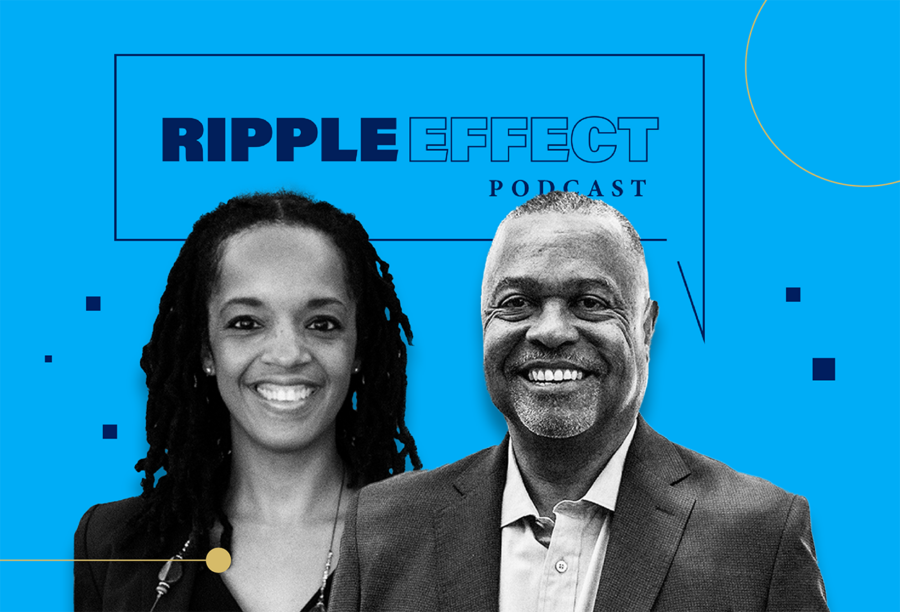Wharton’s Stephanie Creary talks with Kenneth Shropshire about her research into the importance of diverse corporate boards and what companies often get wrong when they go about diversifying them.
In honor of Juneteenth, the Ripple Effect podcast is showcasing a special series of conversations on equity and opportunity, diving deep into the complex issues of racial inequality, bias, and representation within organizations. This special will be led by guest host Kenneth Shropshire, faculty director of Wharton’s Coalition for Equity and Opportunity.
Transcript
The Time for Diversity in Leadership
Kenneth Shropshire: Stephanie, before we talk about boards of directors as a primary focus, I was thinking about the old school/new school kind of thinking about this. Before me, there’s Emancipation, Reconstruction, equal protection. Even before #MeToo are the World War II activities that took place. You’ve got Brown v. Board, the Civil Rights laws that happened in the early ‘60s, then affirmative action. Then we have the retrenchment from affirmative action. We have a negative period. And then George Floyd was this moment forward. Where are we now in this whole DEI space?
Stephanie Creary: We’re in a really interesting time. I think if you were to ask me this question in 2017, when I arrived at the Wharton School, I would tell you that the students believe that we didn’t still have a race problem in America. And certainly, race wasn’t an issue that we needed to discuss outside of the U.S. borders.
That was six years ago. I would say that there had been a lot of indifference among citizens in the U.S., around the world, and certainly among companies, in taking up topics of race. If you were to draw a graph based on the things that you talked about, there’s an uptick at key points in time, key moments around Civil Rights legislation. Then I would say ‘70s, ‘80s, ‘90s, we started to see a downswing in the numbers of activities that corporations were engaging around this topic.
The first movement, if you will, was around 2014 and 2016. I always talk about that as the first Black Lives Matter movement, when we actually thought that the Black Lives Matter movement was some extremist group, right? The average citizen didn’t have an understanding of what these issues were. They didn’t understand why people were talking about police brutality, etc. Obviously, Colin Kaepernick started kneeling. We didn’t think that was a great thing back then.
Then 2020 happens, and it’s this explosion of interest in talking about racism, systemic racism, which was something that was new in our vocabulary as everyday citizens. We saw an explosion of interest in this topic outside of the U.S., and not necessarily talking about American Black lives. They were talking about Japanese lives, and Nigerian lives, and people who were from historically marginalized ethnic groups in their countries.
Where we are now is in a place where there’s a heightened attention to this topic. We still don’t all agree on whether or not racism is an issue or how to address it. But I would say that for people like yourself and myself who study these topics, it’s a good time to be studying and talking about it because there is significant interest in knowing more and learning what we can do.
Studying the Barriers to Increasing Corporate Board Diversity
Shropshire: It is a fantastic time for people who are interested in trying to solve these issues, and leaders really play a role in this. This gets us to boards and thinking about what boards do with companies. Why do we care about having more Blacks or Latinos on boards, as well as other diverse groups? What difference does it make in the context of what we’re talking about? And what can boards do to make companies do that?
Creary: I’m going to tell you what the ideal is, and then I’m going to tell you what I actually study, because these are two different things. The ideal is that boards act as strategic advisers to their firms, but also as people who monitor the firm’s activities and help the firm to make sure that it’s complying with all that’s expected of them from a variety of stakeholder groups. That’s compliance monitoring on the one side. And on the other side, it’s a strategic advisory position.
On a good day, what we want a board to be able to do is to help the firm understand its customer base, the communities it operates in, and to really understand how its products and services can help to solve the needs of people who are part of the stakeholder network. On the other hand, as corporations, they do have responsibilities to the societies that allow them to exist. Here in the U.S., publicly traded companies have relationships with the government. And the government, especially in heavily regulated areas or industries like finance, expect the firm to be following whatever regulations it has set forth.
This gets back to representation. When the board is not representative of stakeholders, doesn’t understand the needs of stakeholder groups, we have a problem. For a very long time, boards were not asked to be representative of the people they serve or the communities in which they operate in a larger stakeholder base. It’s kind of like the government. When the government doesn’t represent the people, the government starts making all sorts of decisions that don’t always reflect the needs of all the people. So, the ideal is that we have a diverse board and, in this case, a racially diverse board that also represents the interests and perspectives of people from a variety of racial groups. That’s the ideal, that these boards will raise issues that are pertinent to the livelihoods of various stakeholder groups, and they will make sure that the CEO and the management team understands how, in the activities that they engage in, to address these stated groups’ needs.
But that’s not what I study. What I study is why boards do not do that, why diversifying a board has been so problematic. Why is it that, even if you have a diverse board, they may not necessarily engage in activities that meet your needs or my needs? It’s a conversation that I hope to continue to build for my own research. I think the conversation about board diversity has spent a lot of time focusing on “getting a more diverse board will help us to perform better,” without fully understanding what the mechanism is that would explain that. It is an important question. But it requires us to not just focus on diversity for diversity’s sake, but to understand that the people who are on the boards are still people. We want them to make decisions that are helpful for us all.
Shropshire: Let me probe a little bit more, then, as someone who sits on a public board and thinks about this issue.
Creary: A financial board, yes?
Shropshire: Correct, a financial board. For anybody who wants to be on a board, the smart question is always, “What’s in the best interest of the shareholders?” That becomes the ultimate stakeholder question. And there are all the legal cases are about was that board member acting in the best interest of the shareholders? Often, that goes to share price, share value. That’s how you translate what’s in the best interest. How does that conflict or meld with this idea of issues that are important with regard to DEI are in the best interest of the company?
Creary: In the last three years, big institutional investors like BlackRock and State Street and Vanguard have made board diversity one of their greatest priorities. And when you read their position papers, they speak a lot about the potential for enhanced financial performance from increased board diversity. They cite all the academic research on this topic. They cite consulting firms’ research on this topic. But beyond that, what they talk about is risk. As a lawyer, you can appreciate the language of risk. And the language of risk is such that if we don’t know our neighbors and understand what their needs are, if we are missing targeting our products and services to certain communities, if we are not following and complying with the regulations that are given to us to abide by as it relates to particular racial groups, then we might have a problem that might hurt our financial performance.
While there’s a lot of conversation around how do we increase our market size and generate revenue by gaining entry into diverse markets, lately the conversation has been about risk mitigation. That’s something that shareholders care about: losing money because we haven’t effectively monitored all of the costs.
What Does Successful Diversity in Leadership Look Like?
Shropshire: So even if you don’t have the bottom-line information about how this will help you be more profitable, as a board member, be aware that there may be other externalities that will come at you that could cost the company money. This gets captured not only in this DEI conversation, but also in the ESG conversation. The “S” of the ESG conversation. You mentioned some big-name companies that are aware of this and highlighting this. How universal is that understanding now, in your work and your conversations? Are you enlightening companies to the broader concern? Or is it something that seems to be in the atmosphere?
Creary: Before coming to Wharton, I was a professor at Cornell. One of my students who worked with me on a variety of research projects moved on to State Street Global Advisors. He works in the unit that has put out all this guidance to firms on what they should be doing. Initially, it was around gender diversity, and more recently was around racial diversity. Ryan and his team and I have had a number of conversations. They’ve interviewed me and a number of other people who are on boards to talk about, what does this conversation look like? What’s an institution’s investors’ role in it?
Because Ryan was my former student, he’s come to Wharton. He has sat in on my diversity classes and actually taught our students. The interesting thing is, we have another student at the Wharton School in our MBA program who used to work in Ryan’s same role at Vanguard. Last fall, it was interesting to hear them talk about their shared responsibilities around meeting with board chairs and helping them to understand why this topic was important and why they should continue to keep topics around diversity, racial equity, gender equity at the top of their conversation.
So, I would say from the perspective of big institutional investors, yes. There’s certainly a lot of attention. As Ryan explained to me, think about your retirement plans and who’s managing that money. Those are the folks, those are the entities that are meeting with board chairs to say, “What are you doing with peoples’ retirement monies? And are you paying attention to ESG and DEI and racial equity? How is the company doing, and is the board actually doing its job to hold the company accountable?” From my perspective, when I see the big institutional investors, yes. There’s certainly a lot of attention.
When you were talking about history, I started thinking about generations. I’m a Generation Xer, so I’m kind of in between a generation of one type of activism and another type of activism. Ryan will define himself as a white American male, which I find super fascinating given who traditionally tends to take up these issues. Ryan is also in his late 20s, as is the average age of our MBA students. And the MBA student who was also taking up this issue around racial equity at Vanguard was a white female.
As a Generation Xer, watching who’s actually doing this work and who’s trying to hold the boards accountable, it’s not people who look like you and me, Ken. It’s actually people who are in their late 20s, and white Americans who have strong sentiments around this topic’s importance.
Shropshire: In The New York Times recently, there was a discussion about a new dictionary that Henry Louis Gates has coming out on the African American language. It’s got all these terms — I kind of chuckled to myself as I heard some of them — that are not broadly known to the rest of the world. One that I was thinking about is “good white folks,” which are white folks that are doing good stuff. That are down, kind of as you’re describing. Can the board be peopled by “good white folks?” And how important is it, just as a proxy, to have a diverse board?
Creary: It’s certainly a question that I’m asked a lot, especially now that we have this new generation that has done a lot to begin to understand the lived experiences of other people. I will talk about these folks as allies. A lot of my work, including my work on board diversity, the academic side of it, is looking at allyship and how that happens and how that works and why that’s important on boards. It is so important that allies like Ryan and this Wharton MBA student exist, and that they are talking about these issues. But that’s not a replacement or a substitute for people who actually come from these communities, have these backgrounds, have these experiences, who are reflective of these subsets.
There’s a different experience that you have when you walk around in that body, in a Black body, in an African American body in the U.S., and you navigate the professional workforce. And heck, when you navigate what it’s like to be a board member, often one of 13. One person who is underrepresented, and the other 12, for example, might be all white. There’s a lot more that comes with that than can be subsumed by somebody who just learned about it from talking to other people. Allies are important. But people who have the lived and the shared experiences of navigating these companies are important as well.
That said, I want to say that just because you’re Black doesn’t mean that you have the same lived experience as another Black person. In my research, what I try to talk about is understanding that when we’re thinking about board diversity, we are trying to capture not just the brown person or the Black person on the board when we’re talking about racial diversity, we’re trying to capture the perspective. I’m probably going to get in trouble when I say this. It is great if everyone on our board got their MBA from the Wharton School. Lots of us would be really, really, really happy. Sometimes what happens is that people say, “We need another woman or we need another Black person. Let’s look and see who else graduated from the Wharton MBA program.”
While that’s nice, it hasn’t truly created the diversity that the board is seeking because that network is small. They’ve probably been taught very similar ways of thinking about businesses. I think one of the next stages for companies today is when they’re thinking about recruiting a diverse board, to step outside their alma mater network. Step outside their client network and find people for the board who are not only on-the-surface different because they have different color skin or they have a different gender identity or whatnot. When we’re recruiting a diverse board, we want everyone to bring different things to the table. And that’s where I think the opportunities are for boards today.
Shropshire: Stephanie, it’s so exciting to speak with you. The big takeaway for me is this idea of thinking about the task of the board members, demographics being important. It just reverberated with me as you said it. Excuse the politics of this, but I think about when Thurgood Marshall was stepping off the Supreme Court, and he was asked whether or not his replacement needed to be Black. He said, essentially, “If it’s a Black snake or a white snake, it still bites.” He wanted somebody that had the presence to make the decisions in the court that were looking out for the interest of civil rights matters in a way that he did, no matter who that person was. Any color, a guiding light. I appreciate everything I’ve learned from you today, and look forward to thinking more.



